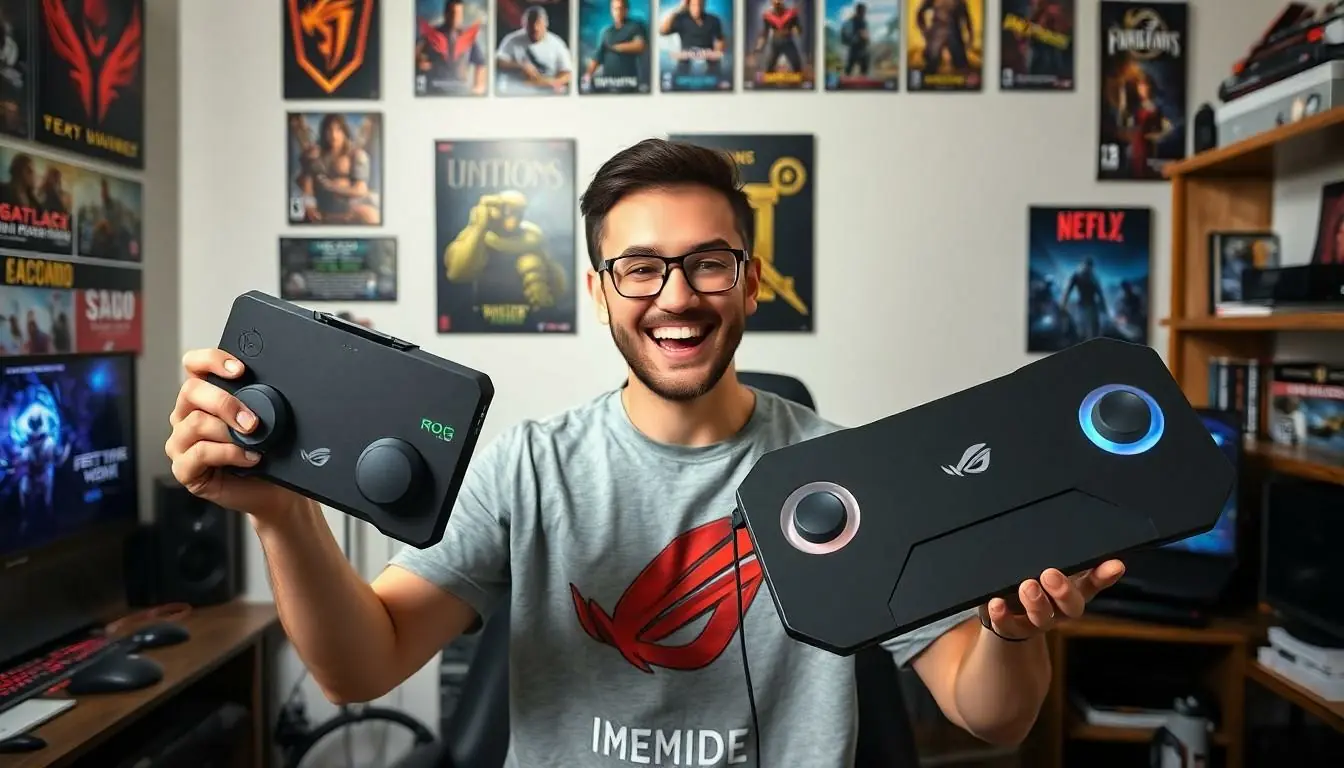In the battle of portable gaming powerhouses, the Asus ROG Ally and Steam Deck are ready to duke it out. Gamers everywhere are itching to know which device reigns supreme in this epic showdown. With the ROG Ally’s sleek design and the Steam Deck’s cult following, choosing between them feels like picking a favorite child—impossible and slightly sacrilegious.
Table of Contents
ToggleOverview of Gaming Handhelds
Gaming handhelds have gained popularity as versatile solutions for on-the-go entertainment. The Asus ROG Ally combines a powerful processing unit with a sleek design, catering to performance-focused gamers. In contrast, the Steam Deck boasts a strong hardware lineup, designed for maximum compatibility across various gaming platforms.
Specifications highlight the ROG Ally’s AMD Ryzen Z1 Extreme processor, which supports high-resolution gaming and smooth frame rates. The Steam Deck’s choice of AMD APU enables a rich gaming experience but emphasizes efficient power consumption. Both devices provide extensive game libraries, ensuring gamers access to numerous titles.
Design elements differentiate these handhelds. The ROG Ally features customizable RGB lighting and high-quality materials, offering an aesthetic appeal. Meanwhile, the Steam Deck emphasizes ergonomics with its textured grips, providing comfort during long gaming sessions.
Battery life plays a crucial role in selecting a handheld. The ROG Ally typically offers up to 7 hours of playtime, depending on usage. The Steam Deck generally provides a slightly lower average of 2 to 8 hours, contingent on game intensity and graphics settings.
Connectivity options also matter. The ROG Ally includes USB-C ports and an HDMI output, enhancing usability with external displays. The Steam Deck supports Bluetooth and Wi-Fi, ensuring seamless integration with other devices and online gaming.
Choosing between these handhelds requires considering personal gaming preferences and usage scenarios. Performance, design, battery life, and connectivity all influence overall satisfaction. Such factors are essential for gamers deciding which device best fits their lifestyle and gaming habits.
Performance Comparison
Performance stands as a critical factor when evaluating the Asus ROG Ally and the Steam Deck. Each device offers distinct advantages that cater to various gaming needs.
Processor and Graphics
Asus ROG Ally utilizes the AMD Ryzen Z1 Extreme processor, providing impressive performance for high-resolution gaming. This aids smooth gameplay and efficient multitasking. In contrast, Steam Deck features a custom AMD APU designed for excellent power consumption and compatibility across numerous titles. Graphics performance remains robust on both devices. ROG Ally’s architecture excels in demanding games. Steam Deck, with its integrated RDNA 2 graphics architecture, delivers solid visuals but lacks the raw power seen in the ROG Ally.
Battery Life
Battery life impacts gaming sessions significantly. ROG Ally delivers up to 7 hours of usage under moderate conditions, allowing for longer play without constant recharging. In comparison, Steam Deck varies between 2 and 8 hours, heavily influenced by gaming demands and settings. Energy efficiency in both devices poses a vital consideration. ROG Ally’s battery management ensures gamers can enjoy extended sessions. Meanwhile, users need to monitor Steam Deck’s performance settings to optimize battery longevity effectively.
Design and Build Quality
The design and build quality of each device play a crucial role in overall user experience. Both the Asus ROG Ally and the Steam Deck offer unique aesthetics and functionality that appeal to gamers.
Ergonomics
Ergonomic design enhances comfort during extended gaming sessions. The Steam Deck prioritizes user comfort, featuring a hand-friendly grip and well-placed buttons. It ensures players maintain a relaxed posture, reducing strain over time. In contrast, the ROG Ally adopts a sleek and modern look, but it also considers ergonomic aspects. The layout of its controls accommodates natural finger placement, optimizing responsiveness during intense gameplay. Both devices aim to keep gamers engaged without discomfort, but preferences may vary based on individual needs.
Display Quality
Display quality significantly affects gaming immersion. The ROG Ally boasts a 7-inch Full HD display with a 120Hz refresh rate, offering vibrant colors and smooth graphics. Gamers can enjoy fast-paced action without motion blur. The Steam Deck, with its 7-inch LCD screen, delivers a 1280×800 resolution. While it may not match the Ally in refresh rate, it still presents clear and sharp visuals. Overall, both devices present commendable displays, each catering to specific gaming preferences and styles.
Game Library and Compatibility
Exploring the game library and compatibility of the Asus ROG Ally and the Steam Deck reveals important factors for gamers. Both devices cater to a wide variety of titles and preferences.
Exclusive Titles
Exclusive titles shape the identity of gaming platforms. The Steam Deck boasts access to an extensive library of games via Steam, including popular titles like “Hades” and “Dota 2.” On the other hand, the ROG Ally presents compatibility with Windows games, allowing users to access a broader selection, including exclusive titles from both the Microsoft Store and third-party platforms. Gamers benefit from unique experiences on both devices, but the Steam Deck excels in first-party exclusive offerings, while the ROG Ally encourages exploration of more game avenues.
Compatibility with PC Games
Compatibility with PC games significantly enhances the gaming experience. The ROG Ally’s Windows operating system allows seamless access to a vast array of titles, including AA and AAA games. Additionally, compatibility extends to existing libraries, giving gamers the chance to enjoy their favorite PC titles on the go. In contrast, the Steam Deck runs a customized SteamOS based on Linux, seamlessly integrating Steam’s library. Though it supports many PC games, some titles may require additional tweaks for optimal gameplay. Overall, the ROG Ally provides superior compatibility with the general PC game library, while the Steam Deck shines with its curated Steam ecosystem.
User Experience
User experience plays a crucial role in determining the overall satisfaction with portable gaming devices like the Asus ROG Ally and Steam Deck.
Controls and Interface
Controls offer different feels and accessibility for gamers. The ROG Ally features responsive triggers and thumbsticks, enhancing precision in gameplay. An intuitive layout allows quick access to essential functions. Steam Deck, on the other hand, provides a layout designed for comfort, ensuring buttons are easily reachable during extended sessions. A trackpad complements the button configuration for those who favor finer control. Different gamers may prefer the ROG Ally’s customization options, letting them swap key functions or backlighting. Alternatively, the Steam Deck uses Valve’s SteamOS, providing seamless integration with the Steam library and an enjoyable interface experience.
Online Features
Online features differ significantly between both devices. The Steam Deck excel in community engagement with built-in access to Steam. Gamers appreciate automatic updates and cloud saves, allowing them to continue gaming on different devices. In contrast, the ROG Ally runs on Windows, opening doors to various online services and platforms beyond Steam. A broader selection of multiplayer games and exclusive titles enhances online play. Adobe connectivity also supports social interaction, whether through gaming networks or social media. Gamers choosing the ROG Ally benefit from expansive online opportunities, while Steam Deck users enjoy a more streamlined gaming ecosystem within the thriving Steam community.
Conclusion
Choosing between the Asus ROG Ally and the Steam Deck ultimately comes down to personal preferences and gaming styles. The ROG Ally impresses with its sleek design and powerful performance while offering extensive game compatibility. On the other hand, the Steam Deck remains a favorite for its ergonomic comfort and strong integration with the Steam ecosystem.
Both devices bring unique advantages to the table. Gamers looking for high-resolution graphics and a broader game library might lean towards the ROG Ally. Those who prioritize comfort and access to a vast collection of Steam titles may find the Steam Deck more appealing. Each handheld has its strengths ensuring that gamers can find a device that aligns with their needs. The choice is personal but rewarding.



